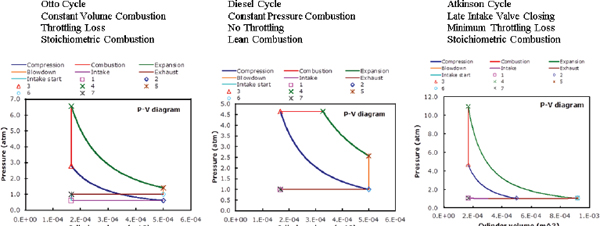Ideal Thermodynamic Cycles for Otto, Diesel, and Atkinson Engines
End of compression pressures shown in Figure D.1 are reasonably representative of actual engines. However, combustion processes differ significantly in actual engines, compared to the idealized cycles. In the Otto and Atkinson cycle spark ignition engines, combustion does not occur at constant volume but instead extends over a significant number of crank angle degrees (as changes in cylinder volume occur). In diesel engines, combustion does not occur at constant pressure, but instead occurs with a shorter duration which results in an increase in pressure during combustion. For these reasons, in actual engines, the diesel engine will have higher peak cylinder pressures than spark ignition engines. This results in the need for a heavier engine structure to contain the higher peak cylinder pressures of diesel engines.

FIGURE D.1 Ideal thermodynamic cycles for Otto, Diesel, and Atkinson engines shown on pressure-volume (P-V) diagrams.
SOURCE: Paul Ronney (2013), University of Southern California, http://ronney.usc.edu.
REFERENCE
Ronney, P. 2013. Ideal Cycle Analysis. AME 436 Lecture 8, Spring. University of Southern California School of Engineering. http://ronney.usc.edu/AME436/Lecture8files/AME436-Lecture8.pptx. Accessed February 25, 2015.

